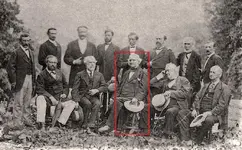sailaway
Hero Member
- Joined
- Mar 2, 2014
- Messages
- 623
- Reaction score
- 816
- Golden Thread
- 0
- Primary Interest:
- All Treasure Hunting
There is error in the theory of Louisiana.
Louisiana was returned to the French for only 1 year before selling it to the United States during which time the negotiations were in motion. The French promised Spain that they would keep it, and weeks later were in negotiation for the sale to the United States. In 1803 the sale was finalized.
General James Wilkinson an Artist in Treason.
https://books.google.com/books?id=E...q=General Wilkinson expert in treason&f=false
The impetus to cede the French colony of Louisiana to the Spanish was the long, expensive conflict of the French and Indian War, also known as the Seven Year’s War, between France and Great Britain. Initially, France offered Louisiana to Spain in order to bring Spain into the conflict on the French side. Spain declined. Spanish officials were uncertain about what exactly constituted the vague and immense colony of Louisiana. When the "Family Compact," a supposedly secret alliance between France and Spain, became known to the British, they attacked Spain. In November 1762 in the secret Treaty of Fontainebleau, France handed over Louisiana and the Isle of Orleans to Spain in order to "sweeten the bitter medicine of Spanish defeat and to persuade them not to fight on" against the British.
The cession of Louisiana was kept secret for over a year. France feared that Louisiana would become British. As a result, France sought to preempt any actions that Britain would undertake if it became known that Louisiana no longer enjoyed French protection before the Spanish were able to occupy and defend it. Great Britain officially conceded Spanish ownership of Louisiana in February 1763 in one of the series of treaties ending the French and Indian War. This gesture was a mere formality, for the territory had been in Spanish hands for almost three months.
Louisiana citizens loyal to the French Crown held a convention in New Orleans on October 29, 1768, to air their grievances against Spanish authority. They formally petitioned the Superior Council to reinstate the colony’s former status and force Ulloa’s departure. The Superior Council issued a decree ordering the expulsion of the Spanish governor and drafted a memorandum to present to the French minister of foreign affairs petitioning for the restoration of French rule, all to no avail. Spain, unwilling to countenance such a revolt, responded with force.
The crown discharged a fleet of 24 ships and 2,000 troops under the command of General Alexandre O’Reilly, who took possession of Louisiana on August 18, 1769. O’Reilly quickly arrested, tried, and convicted the leaders of the rebellion of treason, executing 12 men, sentencing others to lengthy prison terms, and confiscating the properties of all.
O’Reilly also established a series of reforms designed to reassert Spanish authority. In December 1769 he abolished the Superior Council and replaced it with the Cabildo. The Cabildo was a form of municipal government common throughout Spanish America–a city council of 10 members presided over by a governor.
Louisiana: European Explorations and the Louisiana Purchase - Louisiana as a Spanish Colony (American Memory from the Library of Congress)
Louisiana was returned to the French for only 1 year before selling it to the United States during which time the negotiations were in motion. The French promised Spain that they would keep it, and weeks later were in negotiation for the sale to the United States. In 1803 the sale was finalized.
The Treaty of Madrid, 21 March 1801, Spain returned to France the territory of Louisiana which France had ceded to Spain in 1763. "Let the Court of Madrid cede these districts to France," Talleyrand had written, "and from that moment the power of America is bounded by the limit which it may suit the interests and the tranquillity of France and Spain to assign here. The French Republic... will be the wall of brass forever impenetrable to the combined efforts of England and America." Spain was compensated by the creation in Tuscany of the kingdom of Etruria, which was given to the duke of Parma, son-in-law of Charles IV of Spain.
Treaty of San Ildefonso 1800
suggested readingFrance acquired Louisiana from Spain and took possession in 1802, sending a large French army to St. Domingue and preparing to send another to New Orleans. Westerners became very apprehensive about having the more-powerful French in control of New Orleans; President Thomas Jefferson noted,
“There is on the globe one single spot, the possessor of which is our natural and habitual enemy. It is New Orleans.”
https://history.state.gov/milestones/1801-1829/louisiana-purchase
General James Wilkinson an Artist in Treason.
https://books.google.com/books?id=E...q=General Wilkinson expert in treason&f=false
Last edited:





 The "joke" around here is... "Shake the FAMILY TREE, and see what falls out/off"... RAGLAND family papers has ALL.
The "joke" around here is... "Shake the FAMILY TREE, and see what falls out/off"... RAGLAND family papers has ALL. 

